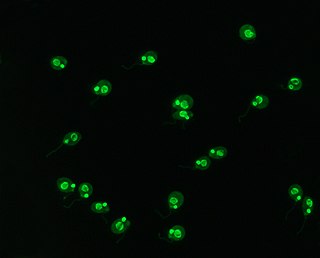User:Simoncaulton/Crithia luciliae
![]() There is already an article named Crithidia luciliae in the mainspace.
There is already an article named Crithidia luciliae in the mainspace.
| Crithidia luciliae[1] | |
|---|---|

| |
| "Immunofluorescence staining pattern of anti-dsDNA antibodies on C. luciliae substrate. The kinetoplast located near the flagellum is stained, indicating the presence of anti-dsDNA antibodies in a person with systemic lupus erythamatosus. | |
| Scientific classification | |
| Domain: | |
| (unranked): | |
| Order: | |
| Family: | |
| Genus: | |
| Species: | C. luciliae
|
| Binomial name | |
| Crithidia luciliae | |
Crithidia luciliae is a flagellate parasitic protist known to use the housefly Musca domestica as a host.[2] As part of the family of Trypanosomatidae, they are characterised by the presence of a kinetoplast; a complex network of interlocking circular dsDNA molecules. The presence of this kinetoplast means they are important in the diagnosis of systemic lupus erythamatosus (SLE). By using C.luciliae as a substrate for immunofluorescence, the organelle can be used to detect anti-dsDNA antibodies, a common feature of the disease.[3][4]
Taxonomy[edit]
C.luciliae is a eukaryotic single-cell protozoan. The family Trypanosomatidae belongs to the order kinetoplastida and is characterised by the presence of the kinetoplast, a network of interlocking circular DNA in a large mitochondrion. All organisms in Kinetoplastida are parasitic, and the host organism for C.luciliae is the housefly Musca domestica.[5][6][7]
Role in systemic lupus erythematosus diagnosis[edit]
The kinetoplast found in C.luciliae allows them to be used for the detection of anti-dsDNA antibodies, a type of anti-nuclear antibody. Anti-nuclear antibodies are a common feature in SLE and anti-dsDNA antibodies are highly specific for the disease. The high concentration of dsDNA and the absence of human nuclear antigens in the kinetoplast provides a specific substrate for the detection of anti-dsDNA antibodies.[8][4]
Purine nucleotide and nucleobase uptake[edit]
As a parasitic protazoan, C.luciliae lacks the ability to biosynthetically produce purine bases and therefore needs to salvage them from the surrounding environment. Three transport systems are used for the uptake of bases from the host organism. One for the uptake of adenosine and its analogues, one for guanosine, its analogues and inosine and one for hypoxanthine, adenine and adenosine.[9]
References[edit]
- ^ "Encyclopedia of Life". Retrieved 27 August 2012.
- ^ JENKINS DW (1964). "PATHOGENS, PARASITES AND PREDATORS OF MEDICALLY IMPORTANT ARTHROPODS. ANNOTATED LIST AND BIBLIOGRAPHY". Bull. World Health Organ. 30: SUPPL:1–150. PMC 2554709. PMID 14245244.
- ^ Donelson JE, Gardner MJ, El-Sayed NM (1999). "More surprises from Kinetoplastida". Proc. Natl. Acad. Sci. U.S.A. 96 (6): 2579–81. PMC 33532. PMID 10077550.
{{cite journal}}: Unknown parameter|month=ignored (help)CS1 maint: multiple names: authors list (link) - ^ a b Kavanaugh A, Tomar R, Reveille J, Solomon DH, Homburger HA (2000). "Guidelines for clinical use of the antinuclear antibody test and tests for specific autoantibodies to nuclear antigens. American College of Pathologists". Arch. Pathol. Lab. Med. 124 (1): 71–81. doi:10.1043/0003-9985(2000)124<0071:GFCUOT>2.0.CO;2. PMID 10629135.
{{cite journal}}: Unknown parameter|month=ignored (help)CS1 maint: multiple names: authors list (link) - ^ Gómez, E (1991 Mar). "What is a genus in the Trypanosomatidae family? Phylogenetic analysis of two small rRNA sequences". Molecular biology and evolution. 8 (2): 254–9. PMID 2046544.
{{cite journal}}: Check date values in:|date=(help); Unknown parameter|coauthors=ignored (|author=suggested) (help) - ^ Opperdoes, Fred R. (NaN undefined NaN). "The trypanosomatidae: Amazing organisms". Journal of Bioenergetics and Biomembranes. 26 (2): 145–146. doi:10.1007/BF00763062.
{{cite journal}}: Check date values in:|date=(help) - ^ Shapiro, TA (1995). "The structure and replication of kinetoplast DNA". Annual review of microbiology. 49: 117–43. PMID 8561456.
{{cite journal}}: Unknown parameter|coauthors=ignored (|author=suggested) (help) - ^ Slater NG, Cameron JS, Lessof MH (1976). "The Crithidia luciliae kinetoplast immunofluorescence test in systemic lupus erythematosus". Clin. Exp. Immunol. 25 (3): 480–6. PMC 1541410. PMID 786521.
{{cite journal}}: Unknown parameter|month=ignored (help)CS1 maint: multiple names: authors list (link) - ^ Hall, ST (1998 Oct). "Crithidia luciliae: functional expression of nucleoside and nucleobase transporters in Xenopus laevis oocytes". Experimental parasitology. 90 (2): 181–8. PMID 9769248.
{{cite journal}}: Check date values in:|date=(help); Unknown parameter|coauthors=ignored (|author=suggested) (help)
